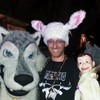Stan the Zombie and legendary horror writer William F. Nolan at the 2015 World Horror Convention in Atlanta. Photo by Beth Gwinn. Courtesy of the Horror Writers Association
The author at ten, with his mother. (Note: This photo was not taken on Halloween.) Photo courtesy of the author
Brad Hodson and Rajiv Patel at the registration table at the 2015 World Horror Convention. Photo by Lisa Morton. Courtesy of the Horror Writers Association
At the end of the "Dark Carnivale" panel a young woman with auburn hair dressed in an outfit that I would call steampunk—tiny top hat and accordion sleeves—comes up to the panelists to present us, each one, with a single tarot.The following night, Friday, at the Creepy Costume Ball, set-dressed by SFX artist Shane Morton, of Mastodon fame, is like Halloween prom where the punch needs more spiking. Cosplayers toddle about. Music thumps. I ask a vampire with a glass of red wine—which is funny, I guess, because they never drink it—to show me his game face. He raises his glass, steps back a pace, and exposes his fangs.Speaking of horror, this VR experience takes you into a 1940s mental hospital on the Creators Project
Two attendees. Photo by the author
In fact, the most fascinating of the panels I attend is earlier that afternoon, called "H. P. Lovecraft in the 21st Century: The Problematic Legacy of the Great Old One of Horror and the Weird." Lovecraft is horror's old-bastard grandfather. He's written such classics as "The Call of Cthulhu," "The Colour Out of Space," and "The Whisperer in the Darkness." He also wrote a despicable poem that goes by the title "On the Creation of Niggers" that refers to black people as "beasts" "filled with vice."I know how I personally feel about Lovecraft, a figure that hangs super-sized over horror. While his tales can be critically smart and arresting, if a little prolix in the way they're deployed, his racism lurks as a constant distraction. If nothing else, such hateful views reinforce a comprehensiveness of awfulness in Lovecraft, coupling the prospect of human extinction at the tentacles of Elder Gods with a dose of incredibly fucked politics. It's misanthropy to the max.This doesn't—shouldn't—can't excuse him. Horror's decidedly working on that. On one hand, he's the patron saint about whom it likes to elide certain facts; on the other, he's still that old-bastard grandfather whom horror can't seem to kick out of the house."Look around the room,' said Usman T. Malik. 'There are around 50 to 60 people in this room. I'm one of two brown faces in this crowd. There's not a single black person. This is where the problem with the dialogue about Lovecraft in the 21st century begins."
Authors Jonathan Maberry and Charlaine Harris. Photo by Ellen Datlow via Flickr
Authors James Dorr and John Everson. Photo by Ellen Datlow via Flickr
Andrew S. Fuller, Ellen Datlow, and Linda Addison. Photo by Beth Gwinn. Courtesy of the Horror Writers Association
